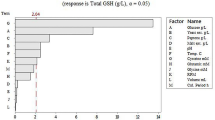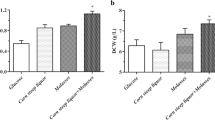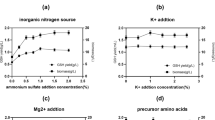Summary
A good cysteine addition method that could increase the specific glutathione (GSH) production rate (G9G) was investigated and utilized to maximize total GSH production in fed-batch culture of Saccharomyces cerevisiae. The single-shot addition of cysteine was a better method compared to a continuous method that maintained a constant cysteine concentration in the reactor. The shot method increased ϱG about twofold compared to a culture without cysteine. The increase in ϱG by the shot method can be achieved without growth inhibition if the cysteine dose is maintained at 0.7 mml·g-1 cell or less. The positive effect on ϱG (at every specific growth rate, µ) was saturated when the cysteine shot concentrations was 3 mM or more. A simple model was developed consisting of mass balance equations and the relationship between µ and ϱG, for the single cysteine shot addition method. From this model an optimal operating strategy was determined to maximize total GSH production in fed-batch culture. This optimal operation consisted of separating the process into phases of (1) cell growth and (2) GSH production, through a bang-bang profile control of µ, and a shot of cysteine just at the start of the GSH production phase. In other words, the cysteine shot time and the µ switching time should be the same. For a total feeding time of 10 h, both the switching time of µ and cysteine shot time were calculated to be about 6.4 h.
Similar content being viewed by others
References
Alfafara C, Kanda A, Araki K, Shimizu H, Shioya S, Suga K (1992) Effect of amino acids on glutathione production by Saccharomyces cerevisiae. Appl Microbiol Biotechnol 36: 538–540
Bannai S (1984) Induction of cysteine and glutamate transport activity in human fibroblasts by diethyl maleate and other electrophilic agents. J Biol Chem 259: 2435–2440
Ellman G (1959) Tissue sulfhydryl groups. Arch Biochem Biophys 82: 70
Issels R, Nagele A, Eckert K, Wilmanns W (1988) Promotion of cystine uptake and its utilization for glutathione biosynthesis induced by cysteamine and N-acetylcysteine. Biochem Pharmacol 37: 881–888
Meister A (1983) Selective modification of glutathione metabolism. Science 220: 472–477
Patoomporn C, Shioya S, Suga K (1991) Maximum histidine production by fed-batch culture of Brevibacterium flavum. J Ferment Bioeng 71: 186–190
Shimizu H, Araki K, Shioya S, Suga K (1991) Optimal production of glutathione by controlling the specific growth rate of yeast in fed-batch culture. Biotechnol Bioeng 38: 196–205
Tietze F (1969) Enzymatic method for quantitative determination of nanogram amounts of total and oxidized glutathione: application to mammalian blood and other tissues. Anal Biochem 29: 502
Author information
Authors and Affiliations
Rights and permissions
About this article
Cite this article
Alfafara, C., Miura, K., Shimizu, H. et al. Cysteine addition strategy for maximum glutathione production in fed-batch culture of Saccharomyces cerevisiae . Appl Microbiol Biotechnol 37, 141–146 (1992). https://doi.org/10.1007/BF00178160
Received:
Accepted:
Issue Date:
DOI: https://doi.org/10.1007/BF00178160




